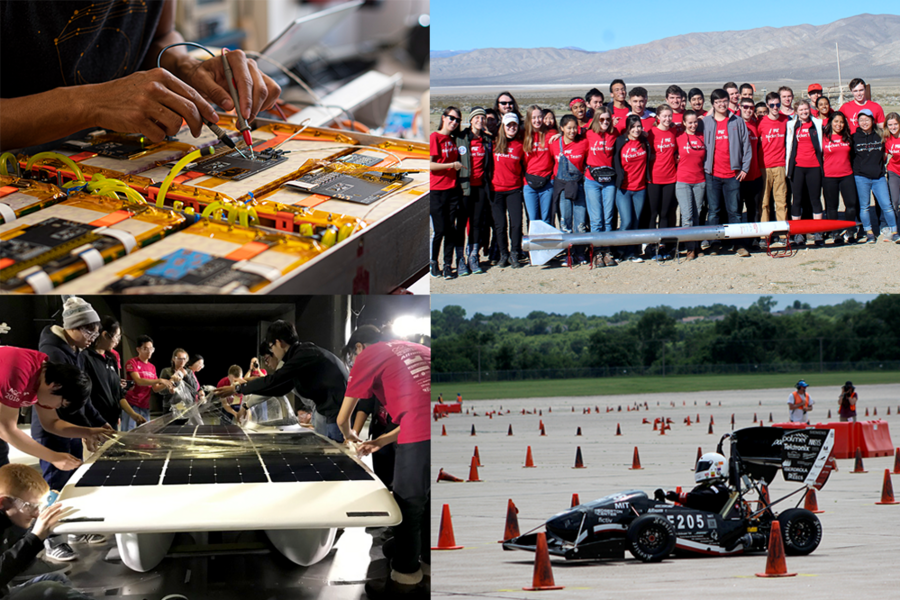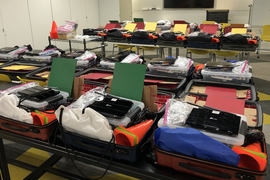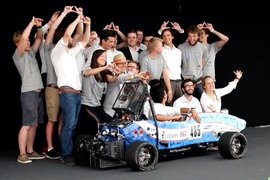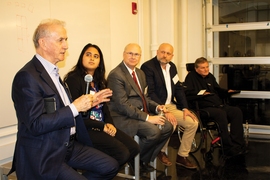The Covid-19 pandemic has hit all areas of the MIT communty. Those for which in-person hands-on experiences traditionally take center stage have had to pivot in unique ways.
In this Q&A, the MIT Edgerton Center checked in with with leaders of three of the Institute's student teams that traditionally plan their activities around engineering vehicles or devices in preparation for national or international competitions. Here, juniors Max Kwon, president of the MIT Rocket Team; Jorge Nin, MIT Motorsports captain; and Aditya Mehrotra, captain of MIT Solar Electric Vehicle Team describe how the pandemic has affected their operations and plans for the future. Interviews were edited for length and clarity.
Q: Could you introduce your teams to the MIT community?
Max Kwon: The MIT Rocket team is comprised of a majority of undergraduate students, with a few graduate students. Our aim is to build a two-stage rocket that crosses the Kármán Line, which is the recognized boundary of space.
Jorge Nin: MIT Motorsports is a student team for undergrads who design, manufacture, build, and test a formula-style electric race car. At the end of the year, we end up competing against other [student] teams.
Aditya Mehrota: MIT Solar Team was founded 30 years ago, so it’s one of the oldest teams on campus. We design and build solar powered vehicles to race in international solar competitions.
Q: All three of you recently assumed leadership of your teams. What did your initial plans look like?
Kwon: When I became president in January, I had a specific vision for what the team would be doing for the year. We were working on Project Phoenix, a two-stage rocket. By the end of spring 2020, we wanted to independently launch our second stage, just as a test. [So the plan was that] we build the second stage, we take it out, probably some rocket launch field in New York, and we test our system there. It’s always fun to go out and see a rocket launch. And then over the summer and the fall, we keep developing this rocket, we come back, we build the first stage, and then in IAP of 2021, we’d go out to California into the Mojave Desert and launch the full two-stage rocket.
Nin: So right before Covid-19 hit, we had just hit one of our major milestones. There are three big ones. The first is the design phase. After that we have “rolling,” when the car has the wheels on it and we can push it forward, and you can turn the steering wheel. And then you have “Roman,” the first time that the car drives on its own power. We had just hit “Roman.” In fact, it was the fastest we've ever hit “Roman” in recent team memory.
Mehrotra: Our team operates on a two-year cycle: our first year is a design year, and the second is a build year. This year we were building [the car]. On spring break, we were going to take the car on a road trip to test it. And what this would have allowed us to do was spend the rest of that semester fixing up the car and getting the team ready for the American Solar Challenge 2020.
Q: And then of course, the pandemic happened. In March, MIT asked students to leave campus. What did that mean for your team’s plans?
Kwon: It was all thrown up in the air. Obviously, we couldn't launch the second stage. We couldn't have that test launch at the end of the semester.
Nin: We’d just hit “Roman.” And we were really excited because we were on a really good path forward to win the summer competition. And then we were informed that we would all have to leave campus. It was very sad — a week later we were going to go to Palmer racetrack to try out the car for the first time.
Mehrotra: We were supposed to be racing the vehicle this summer. But then students were asked to leave campus because of the pandemic. We weren't able to go out and test the car. And of course, we were unable to race this summer. The good news was, because our car drives on real roads, we needed to get the car registered with the DMV [and we] were able to get the car registered the last week before students left for campus. So we should be getting our license plate soon. So that was kind of a pick-me-up for people.
Q: How did your teams confront the crisis?
Kwon: It definitely was difficult. But I think the entire team has done a really good job of staying on top of things. I'd honestly say we were pretty lucky that we weren't in a manufacturing phase. We were in a design phase. So we knew that there [was] stuff we could do. What quarantine has allowed us to do is slow down, take a step back, and kind of run through the engineering design process. The way it should be.
Nin: We had all these crazy ideas. Like maybe we ship this car to Los Angeles, and then we test over there for a little bit. In the end, we ended up leaving the car in the garage and we all went home. And that's when we decided to transfer over executive power from last year's team. So, what we started doing after that is planning out what we would do for the next year and how we could take advantage of the situation.
We also had a unique challenge in that this year we didn't have many sophomores. We had a lot of seniors, a lot of first-years. That was a big issue in terms of our knowledge transfer because we're going to have a lot of information that was going to be lost if you couldn't transfer it over to the members. And that's really what we're trying to focus on during this time: knowledge transfer.
Mehrotra: Of course, the team was disappointed. But at the moment our team is laying low a little bit because there's not that much we can really do right now. To finish the car, we need to be [there] in person. The race wasn't fully canceled, it was postponed to next summer. So [American Solar Challenge] is going to happen in the summer of 2021. So our team is going to start focusing on preparing for that as soon as we know the plan going forward.
Q: How did MIT's announcement that only seniors would return to campus this semester change things for your team?
Kwon: The original plan was to come back in the fall and begin work on the manufacturing of the second stage of the rocket and then launch that second stage during IAP [Independent Activities Period, in January]. Because only seniors were allowed to go back to campus, [this was] not a possibility. This semester, we will have some seniors who will be able to do small manufacturing tasks. But we are going to be nowhere near ready to launch by [January]. Our stated goal is still to launch the full stack — the first and the second stage, together — in the summer of 2021. But that's a goal that will also have to be reassessed depending on what the spring semester looks like. But because we're not doing so much with the rocket over the fall, we're diverting a lot of our energy into recruitment and team skills building.
Nin: The biggest change really has just been focusing more over the fall on R&D projects and trying to make sure that we can transfer as much knowledge from the seniors to the rest of the members. In spring, we will focus more on getting the car up to speed, because we will have limited people and we won't have an IAP to build a new car. It just becomes very difficult to build one from scratch.
Mehrotra: It does change our timeline a little bit. What we're probably going to end up doing is going to be more focused on things like design, integrating new members into the team. And I think we're holding off until the spring to really decide what we want to do because by January, I think we'll have a more accurate understanding based on how the situation progresses on whether we're going to be able to compete this summer or if we're going to have to hold off. And maybe just race the car we're currently building not this summer, but two summers from now.
Q: What would you like the MIT community to know about your teams?
Kwon: I'm sure it's the same for all Edgerton Center teams. We've all been hit the same way. And I'm just personally impressed with the team and how we've been able to go through quarantine and be productive. [The team has] been super supportive of helping us get through quarantine and meet our goals that we've had for the semester. And I think the fact that our rocket team has pushed so, so hard, even through quarantine — it really just shows the spirit of MIT.
To experience building something with your peers and watching it, literally launch and fly, is such a rewarding experience that I hope everyone outside the Edgerton Center can appreciate and see. The work that the EC is doing and the work that the teams are doing inside of it really is something that matters and is what makes MIT, MIT.
Nin: I really, really love how much people put effort into trying to build a car and how much it means for people and the great friendships that are formed. Both through the good times and especially through the bad times when a project isn't working at 2 a.m. and you just have to pull through to get it ready for a competition.
Mehrotra: Having a good team around you takes a lot of stress off of you when making decisions. So I'm fortunate enough to have good team members not only on the regular team but on my executives as well. I really love our team because of the focus our team puts on learning and the opportunities students get from joining teams like ours. And more importantly than just for MIT students, I think our team has always been a team that tries to do like community outreach to whatever extent we can.









